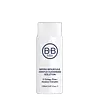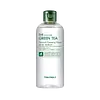What's inside
What's inside
 Key Ingredients
Key Ingredients

 Benefits
Benefits

 Concerns
Concerns

No concerns
 Ingredients Side-by-side
Ingredients Side-by-side

Water
Skin ConditioningPEG-6 Caprylic/Capric Glycerides
EmulsifyingSodium PCA
HumectantGlycerin
HumectantPEG-40 Hydrogenated Castor Oil
EmulsifyingDipropylene Glycol
HumectantHydroxyacetophenone
AntioxidantCaprylyl Glycol
EmollientCitric Acid
BufferingSodium Hydroxide
BufferingAloe Barbadensis Leaf
MaskingDurio Zibethinus Fruit Extract
Skin ConditioningGarcinia Mangostana Peel Extract
Skin ConditioningLactococcus Ferment Lysate
Skin ConditioningInulin
Skin ConditioningXylitylglucoside
HumectantAnhydroxylitol
HumectantAlpha-Glucan Oligosaccharide
CleansingXylitol
HumectantDipotassium Glycyrrhizate
HumectantSaccharomyces Lysate
Skin Conditioning1,2-Hexanediol
Skin ConditioningXanthan Gum
EmulsifyingDisodium Succinate
MaskingPhenoxyethanol
PreservativeEthylhexylglycerin
Skin ConditioningValine
MaskingThreonine
Glutamic Acid
HumectantGlycine
BufferingButylene Glycol
HumectantGlucose
HumectantSodium Hyaluronate
HumectantChondrus Crispus Extract
Skin ConditioningHydroxypropyltrimonium Hyaluronate
Hydrolyzed Hyaluronic Acid
HumectantSodium Acetylated Hyaluronate
HumectantHyaluronic Acid
HumectantSodium Hyaluronate Crosspolymer
HumectantHydrolyzed Sodium Hyaluronate
Skin ConditioningPotassium Hyaluronate
Skin ConditioningWater, PEG-6 Caprylic/Capric Glycerides, Sodium PCA, Glycerin, PEG-40 Hydrogenated Castor Oil, Dipropylene Glycol, Hydroxyacetophenone, Caprylyl Glycol, Citric Acid, Sodium Hydroxide, Aloe Barbadensis Leaf, Durio Zibethinus Fruit Extract, Garcinia Mangostana Peel Extract, Lactococcus Ferment Lysate, Inulin, Xylitylglucoside, Anhydroxylitol, Alpha-Glucan Oligosaccharide, Xylitol, Dipotassium Glycyrrhizate, Saccharomyces Lysate, 1,2-Hexanediol, Xanthan Gum, Disodium Succinate, Phenoxyethanol, Ethylhexylglycerin, Valine, Threonine, Glutamic Acid, Glycine, Butylene Glycol, Glucose, Sodium Hyaluronate, Chondrus Crispus Extract, Hydroxypropyltrimonium Hyaluronate, Hydrolyzed Hyaluronic Acid, Sodium Acetylated Hyaluronate, Hyaluronic Acid, Sodium Hyaluronate Crosspolymer, Hydrolyzed Sodium Hyaluronate, Potassium Hyaluronate
 Reviews
Reviews

Ingredients Explained
These ingredients are found in both products.
Ingredients higher up in an ingredient list are typically present in a larger amount.
Citric Acid is an alpha hydroxy acid (AHA) naturally found in citrus fruits like oranges, lemons, and limes.
Like other AHAs, citric acid can exfoliate skin by breaking down the bonds that hold dead skin cells together. This helps reveal smoother and brighter skin underneath.
However, this exfoliating effect only happens at high concentrations (20%) which can be hard to find in cosmetic products.
Due to this, citric acid is usually included in small amounts as a pH adjuster. This helps keep products slightly more acidic and compatible with skin's natural pH.
In skincare formulas, citric acid can:
While it can provide some skin benefits, research shows lactic acid and glycolic acid are generally more effective and less irritating exfoliants.
Most citric acid used in skincare today is made by fermenting sugars (usually from molasses). This synthetic version is identical to the natural citrus form but easier to stabilize and use in formulations.
Read more about some other popular AHA's here:
Learn more about Citric AcidDipropylene Glycol is a synthetically created humectant, stabilizer, and solvent.
This ingredient helps:
Dipropylene glycol is technically an alcohol, but it belongs to the glycol family (often considered part of the ‘good’ alcohols). This means it is hydrating and gentle on skin unlike drying solvent alcohols like denatured alcohol.
As a masking agent, Dipropylene Glycol can be used to cover the smell of other ingredients. However, it does not have a scent.
Studies show Dipropylene Glycol is considered safe to use in skincare.
Learn more about Dipropylene GlycolEthylhexylglycerin (we can't pronounce this either) is commonly used as a preservative and skin softener. It is derived from glyceryl.
You might see Ethylhexylglycerin often paired with other preservatives such as phenoxyethanol. Ethylhexylglycerin has been found to increase the effectiveness of these other preservatives.
Peg-40 Hydrogenated Castor Oil is derived from castor oil and polyethylene glycol (PEG). It is used as a emollient and emulsifier.
As an emulsifier, it helps prevent ingredients from separating. It also helps make the other ingredients more soluble; it is often used to solubilize fragrances. This increases spreadability and elongates shelf life in a product.
Emollients help soothe and soften the skin. They do this by creating a protective film on your skin. This barrier helps trap moisture and keeps your skin hydrated. Emollients may be effective at treating dry or itchy skin.
This ingredient may or may not be vegan, depending on the source.
Peg-40 Hydrogenated Castor Oil may not be fungal-acne safe. We recommend speaking with a professional if you have any questions or concerns.
Learn more about PEG-40 Hydrogenated Castor OilThis ingredient is derived from caprylic and capric acids. It is an emulsifier with emollient properties.
According to the manufacturer, it is hydrophilic and soluble in aqueous solutions (water). They also state this ingredient is stable in a medium pH range (~5 - 8).
As an emulsifier, it helps make oils and oil-soluble ingredients more soluble in water.
Learn more about PEG-6 Caprylic/Capric GlyceridesPhenoxyethanol is a preservative that has germicide, antimicrobial, and aromatic properties. Studies show that phenoxyethanol can prevent microbial growth. By itself, it has a scent that is similar to that of a rose.
It's often used in formulations along with Caprylyl Glycol to preserve the shelf life of products.
Water. It's the most common cosmetic ingredient of all. You'll usually see it at the top of ingredient lists, meaning that it makes up the largest part of the product.
So why is it so popular? Water most often acts as a solvent - this means that it helps dissolve other ingredients into the formulation.
You'll also recognize water as that liquid we all need to stay alive. If you see this, drink a glass of water. Stay hydrated!
Learn more about Water